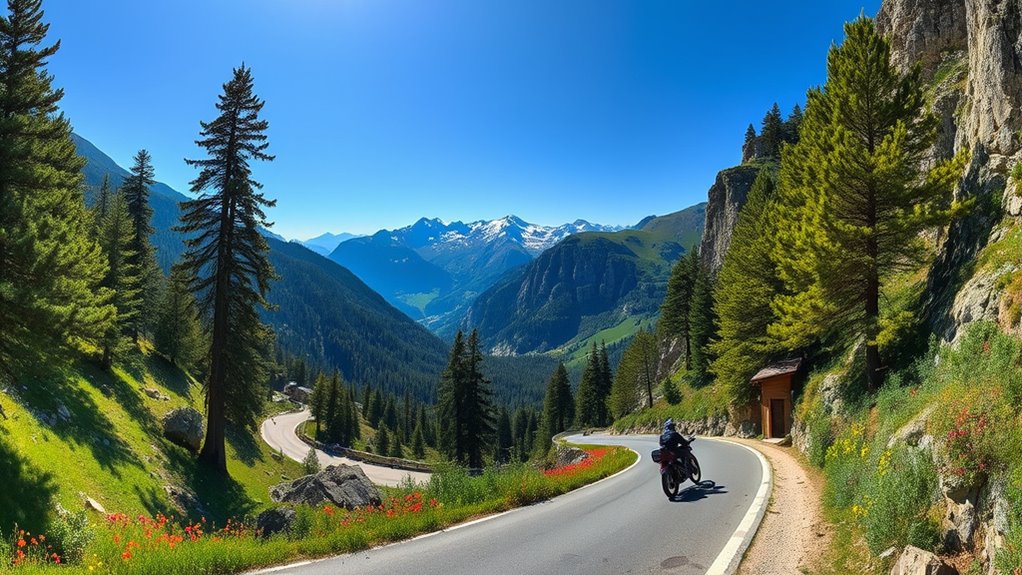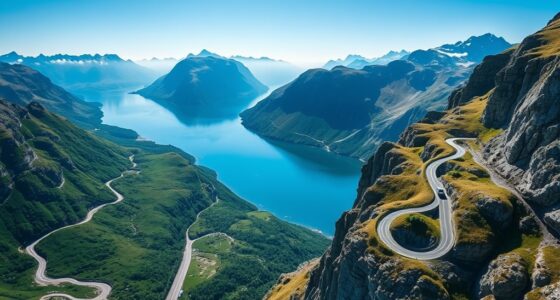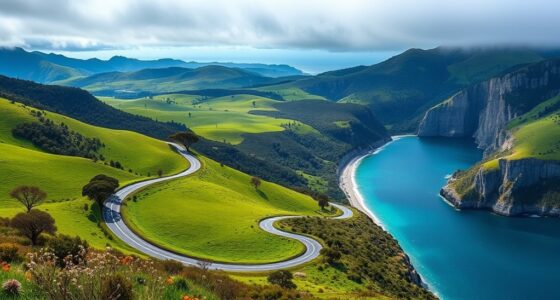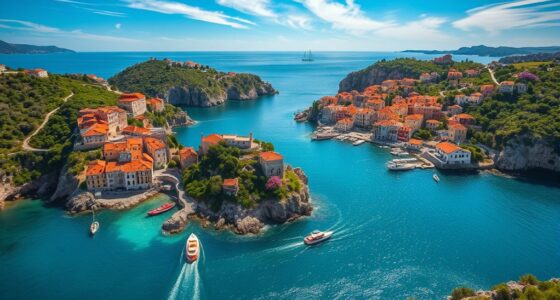Following Napoleon’s path through the French Alps takes you on a journey through history, stunning scenery, and charming towns. You’ll pass historic landmarks linked to his campaigns, enjoy panoramic mountain views, and explore picturesque villages like Castellane. The route offers breathtaking viewpoints, local cultural experiences, and a chance to see the legacy of his military triumphs firsthand. As you explore further, you’ll uncover even more about this remarkable route and its rich stories.
Key Takeaways
- The Route Napoleon traces Napoleon’s historic campaigns across France and the Alps, highlighting landmarks like Château de Montauban.
- It offers scenic drives through stunning French Alps landscapes, including valleys, peaks, and lakes, with panoramic viewpoints.
- The route features picturesque towns such as Castellane and Digne-les-Bains, known for regional cuisine and cultural heritage.
- Numerous stops at viewpoints and historic villages allow travelers to enjoy breathtaking scenery and explore Napoleon-related sites.
- The journey combines history, natural beauty, and local culture, providing a personalized and immersive experience through Napoleon’s legacy.

Have you ever wondered about the historic path that linked Napoleon’s triumphs in France and Italy? The Route Napoleon traces that very journey, winding through the stunning French Alps and offering a unique glimpse into history while immersing you in breathtaking scenery. As you follow this legendary route, you’ll pass by numerous historic landmarks that tell stories of Napoleon’s military campaigns and political rise. From ancient forts to charming villages, each site adds a layer of depth to your journey. You might stop at the Château de Montauban, where Napoleon’s troops once gathered, or explore small towns that have preserved their traditional architecture, giving you a sense of stepping back in time.
Discover Napoleon’s historic route through stunning French Alps and charming villages full of stories and scenic views.
The route itself is designed to showcase the natural beauty of the region, with scenic viewpoints that promise spectacular vistas at every turn. As you ascend through mountain passes, you’ll be treated to panoramic views of lush valleys, rugged peaks, and shimmering lakes. These viewpoints are perfect spots to pause, take photos, and soak in the grandeur of the French Alps. Whether you’re traveling in spring when wildflowers bloom or in winter when snow blankets the landscape, the scenery remains awe-inspiring. The route’s curves and switchbacks also add an element of adventure, making each scenic viewpoint feel like a rewarding discovery.
Driving along the Route Napoleon allows you to experience the landscape at your own pace, stopping whenever a scenic viewpoint catches your eye. Imagine pulling over to admire the sweeping mountain ranges or exploring a historic village nestled in the hillside. Many of these viewpoints are accessible by car, but some may require short walks, giving you a chance to stretch your legs and enjoy the fresh mountain air. The route is well-marked, and local signs often highlight notable historic landmarks, so you’re never lost in the journey. As you pass through picturesque towns like Castellane or Digne-les-Bains, you’ll find cafes and markets where you can sample regional specialties, adding a delightful flavor to your travels.
In essence, following the Route Napoleon isn’t just about tracing Napoleon’s path; it’s about experiencing a harmonious blend of history, culture, and natural beauty. The historic landmarks give you a tangible connection to the past, while the scenic viewpoints ensure your journey is visually unforgettable. Whether you’re a history enthusiast or a lover of scenic drives, this route offers a compelling adventure that captures the spirit of the French Alps and Napoleon’s enduring legacy. Additionally, learning about historical landmarks along the route enriches your understanding of the region’s significance in Napoleon’s era.
Frequently Asked Questions
What Is the Best Time of Year to Travel Route Napoleon?
The best time of year to travel Route Napoleon is in late spring or early fall. Seasonal considerations, like mild weather conditions, make these months ideal for a comfortable journey. You’ll encounter less snow and cooler temperatures, which are perfect for driving or cycling. Avoid summer peak season, as it can be crowded, and winter, when snow and cold weather conditions may restrict access.
Are There Guided Tours Available Along Route Napoleon?
You’ll find plenty of guided tours and travel packages along Route Napoleon, making it easy to explore Napoleon’s historic path. These tours often include expert guides who bring history to life, local insights, and convenient transportation. Whether you prefer small group adventures or private excursions, there’s a variety to choose from. Booking in advance guarantees you secure your spot and enjoy a hassle-free experience maneuvering the stunning French Alps.
How Long Does It Take to Drive the Entire Route?
You’ll need about 4 to 6 hours for the driving duration of the entire Route Napoleon, depending on how often you stop and explore along the way. The travel time can extend if you take your time visiting towns, scenic spots, or enjoying local cuisine. To make the most of your trip, plan for a full day, especially if you want to soak in the breathtaking views and historic sites along the route.
What Are Some Must-See Historical Sites Along the Route?
As you travel along the route, make sure to visit key Napoleonic landmarks like the Château de Malmaison and the Maison Bonaparte in Ajaccio. Don’t miss exploring the historical ruins at the Col de la Croix de Bauzon and the Fort de la Platte. These sites offer a glimpse into Napoleon’s life and military history, enriching your journey with fascinating stories and stunning scenery.
Is the Route Suitable for Cycling or Walking Trips?
You’ll find that the Route Napoleon is perfect for cycling routes and walking trails, offering a thrilling adventure through stunning alpine scenery. With over 300 kilometers of scenic paths, more than half are suitable for cycling or walking. You’ll enjoy well-marked trails, diverse terrains, and breathtaking views, making it an ideal choice whether you prefer pedaling or strolling through historic landscapes and picturesque villages along Napoleon’s historic journey.
Conclusion
As you follow Napoleon’s route through the French Alps, you realize it’s like tracing a river’s course—each twist and turn revealing a new story. Just as a river carves its path through mountains over centuries, this journey immerses you in history and adventure. You might find yourself feeling like a part of something larger, flowing through time and terrain, discovering that sometimes, the most unforgettable journeys are those that follow a path carved by legends.









